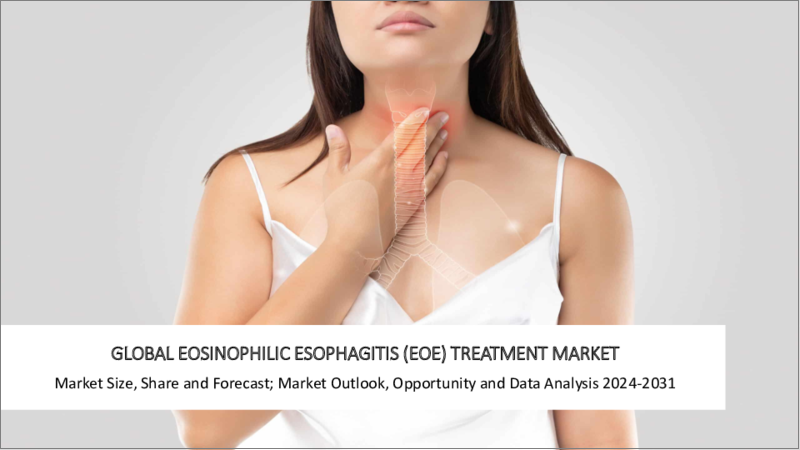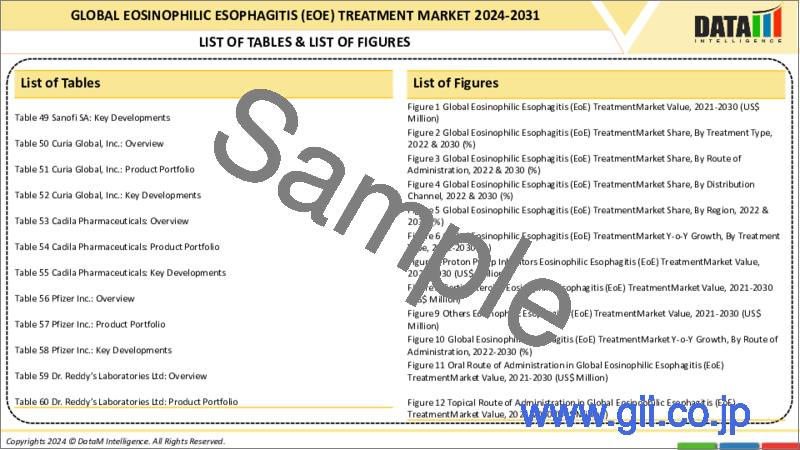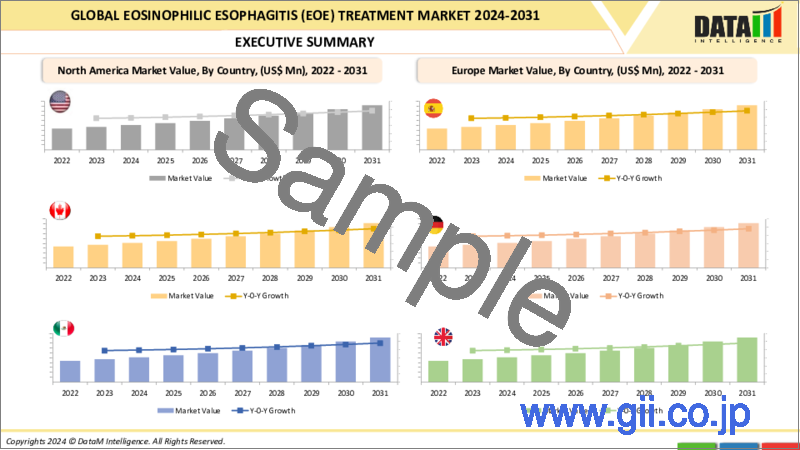|
|
市場調査レポート
商品コード
1374829
好酸球性食道炎(EoE)治療の世界市場-2023年~2030年Global Eosinophilic Esophagitis (EoE) Treatment Market - 2023-2030 |
||||||
カスタマイズ可能
適宜更新あり
|
|||||||
| 好酸球性食道炎(EoE)治療の世界市場-2023年~2030年 |
|
出版日: 2023年11月01日
発行: DataM Intelligence
ページ情報: 英文 187 Pages
納期: 即日から翌営業日
|
- 全表示
- 概要
- 目次
概要
好酸球性食道炎(EoE)は、好酸球と呼ばれる白血球が食道に大量に存在する消化器系の慢性アレルギー性疾患または免疫疾患です。特定の白血球が過剰になることで食道に炎症が起こります。食物アレルギーが原因の一つと考えられています。この疾患は、嘔吐、胃や胸の痛み、成長障害(特に小児)、嚥下困難、のどに食べ物が詰まるなどの症状を特徴とします。
好酸球性食道炎の治療法はありませんが、一部の治療薬(ブデソニド・フルチカゾンプロピオン酸エステルなどのコルチコステロイド、オメプラゾール・パントプラゾール・エソメプラゾール・ラベプラゾールなどのプロトンポンプ阻害薬)の服用や、乳製品・卵・小麦・大豆・ピーナッツ・木の実・魚などの特定の食品を食事から除去することで、食道の発赤や腫れを抑えることができます。
市場力学:促進要因
革新的治療薬の採用増加
革新的な治療薬の採用が増加していることが、予測期間中の世界市場を牽引すると予想されます。好酸球性食道炎治療のための革新的な治療薬は、より良い疾患治療とより良い患者の転帰のための代替または補完的な治療オプションを提供することにより、疾患とそれに関連する合併症の管理および治療に関連するアンメットニーズに対処することを目的としています。
例えば、2023年9月26日、Regeneron Pharmaceuticals, Inc.とSanofiは、米国食品医薬品局(FDA)が好酸球性食道炎(EoE)の1歳から11歳の小児を治療するためのデュピクセント(デュピルマブ)の生物製剤追加承認申請を優先審査として受理したことを明らかにしました。
さらに、好酸球性食道炎治療においてより良い結果を示す新規治療薬の開発に向けて、多くの臨床試験が進行中です。例えば、2022年10月12日、革新的なドラッグデリバリー技術プラットフォームを有する臨床段階のバイオテクノロジー企業であるEupraxia Pharmaceuticals Inc.は、食物を飲み込む能力を制限し、生活の質に大きな影響を与える希少疾患である好酸球性食道炎(EoE)に罹患している成人患者を対象としたEP-104IARの第2相試験の開始を発表しました。
さらに、革新的な治療薬の開発に対する規制当局の承認は、新規治療薬の開発に対する患者の信頼を高めます。例えば、2021年10月8日、テゼペルマブは好酸球性食道炎(EoE)の治療薬として米国食品医薬品局(FDA)から希少疾病用医薬品指定(ODD)を取得しました。テゼペルマブはアストラゼネカがアムジェンと共同開発中で、米国では喘息患者を対象に優先審査中です。
さらに、好酸球性食道炎(EoE)の有病率の増加、FDA承認などの規制当局による承認の増加、臨床試験の増加、治療選択肢の利用可能性に関する認知度の向上、新薬や治療法の開発における技術進歩などが、予測期間中の市場の牽引役となることが予想されます。
抑制要因
副腎皮質ステロイドやその他の薬剤の使用に伴う合併症、好酸球性食道炎(EoE)の治療にかかる高額な費用、治療のためのより良い適切な治療薬の不足といった要因が市場の抑制要因になると予想されます。
目次
第1章 調査手法と調査範囲
第2章 定義と概要
第3章 エグゼクティブサマリー
第4章 市場力学
- 影響要因
- 促進要因
- 革新的治療薬の採用増加
- 抑制要因
- 副腎皮質ステロイドの使用に伴う合併症
- 機会
- 影響分析
- 促進要因
第5章 産業分析
- ポーターのファイブフォース分析
- サプライチェーン分析
- 価格分析
- 規制分析
- パイプライン分析
- アンメットニーズ
- 特許分析
- ボリューム分析
- DMIの見解
第6章 COVID-19分析
第7章 治療タイプ別
- プロトンポンプ阻害薬
- オメプラゾール
- パントプラゾール
- エソメプラゾール
- ラベプラゾール
- その他
- 副腎皮質ステロイド
- ブデソニド
- プロピオン酸フルチカゾン
- その他
- その他
第8章 投与経路別
- 経口剤
- 局所剤
- その他
第9章 流通チャネル別
- 病院薬局
- 小売薬局
- オンライン薬局
第10章 地域別
- 北米
- 米国
- カナダ
- メキシコ
- 欧州
- ドイツ
- 英国
- フランス
- イタリア
- スペイン
- その他欧州
- 南米
- ブラジル
- アルゼンチン
- その他南米
- アジア太平洋
- 中国
- インド
- 日本
- オーストラリア
- その他アジア太平洋
- 中東・アフリカ
第11章 競合情勢
- 競合シナリオ
- 市況/シェア分析
- M&A分析
第12章 企業プロファイル
- Takeda Pharmaceutical Company Limited
- 会社概要
- 製品ポートフォリオと説明
- 財務概要
- 主な動向
- AstraZeneca PLC
- Regeneron Pharmaceuticals, Inc.
- Revolo Biotherapeutics
- Landos Biopharma, Inc.
- Sanofi SA
- Curia Global, Inc.
- Cadila Pharmaceuticals
- Pfizer Inc.
- Dr. Reddy's Laboratories Ltd.
第13章 付録
Overview
Eosinophilic esophagitis (EoE) is a chronic allergic or immune disorder of the digestive system in which large numbers of white blood cells called eosinophils are present in the esophagus. It causes an inflammation of the esophagus caused by an overabundance of certain white blood cells. Food allergies are thought to be one cause of the condition. This condition is characterized by vomiting, stomach or chest pain, failure to thrive (particularly in children), difficulty swallowing and food getting stuck in the throat.
Eosinophilic esophagitis has no cure, but certain medicines, such as corticosteroids such as budesonide and fluticasone propionate, proton pump inhibitors such as omeprazole, pantoprazole, esomeprazole, rabeprazole and others, and eliminating specific foods such as dairy products, eggs, wheat, soy, peanut, tree nuts, and fish from the diet can help reduce the redness and swelling in the esophagus.
Market Dynamics: Drivers
Increasing adoption of innovative therapeutics
The increasing adoption of innovative therapeutics is expected to drive the global market over the forecast period. The innovative therapeutics for the treatment of eosinophilic esophagitis aim to address the unmet needs associated with the management and treatment of the disease and its associated complications by providing alternative or complementary treatment options for better disease treatment and better patient outcomes.
For instance, on September 26, 2023, Regeneron Pharmaceuticals, Inc. and Sanofi cleared that the U.S. Food and Drug Administration (FDA) has accepted for Priority Review the supplemental Biologics License Application for Dupixent (dupilumab) to treat children aged 1 to 11 years with eosinophilic esophagitis (EoE).
Moreover, many clinical trials are going on for the development of novel therapeutics that show better results in eosinophilic esophagitis treatment. For instance, on October 12, 2022, Eupraxia Pharmaceuticals Inc., a clinical-stage biotechnology company with an innovative drug delivery technology platform, released the initiation of a Phase 2 trial of EP-104IAR in adult patients afflicted with eosinophilic esophagitis (EoE), a rare disease that restricts the ability to swallow food and greatly impacts the quality of life.
In Addition, the regulatory approvals for the development of innovative therapeutics increase the trust in patients about the development of novel therapeutics. For instance, on 8 October 2021, Tezepelumab was granted Orphan Drug Designation (ODD) in the US by the Food and Drug Administration (FDA) for the treatment of eosinophilic esophagitis (EoE). Tezepelumab is being developed by AstraZeneca in collaboration with Amgen and is under Priority Review for patients with asthma in the US.
Further, the increasing prevalence of eosinophilic esophagitis (EoE), rising regulatory approvals such as FDA approvals, increasing clinical trials, increasing awareness about the availability of treatment options and technological advancements in developing novel drugs and therapies are expected to drive the market over the forecast period.
Restraints
Factors such as complications associated with the use of corticosteroids and other drugs, the high cost of the treatment of eosinophilic esophagitis (EoE) and the lack of better and appropriate therapeutics for the treatment are expected to hamper the market.
Segment Analysis
The global eosinophilic esophagitis (EoE) treatment market is segmented based on treatment type, route of administration, distribution channel and region.
The corticosteroids segment accounted for approximately 51.1% of the eosinophilic esophagitis (EoE) treatment market share
The corticosteroids segment is expected to hold the largest market share over the forecast period. Usually, there is no cure for eosinophilic esophagitis (EoE), but corticosteroids such as budesonide and fluticasone propionate are most commonly used and are considered first-line therapeutics for the management of this condition. Corticosteroids constitute the mainstay of EoE treatment and are frequently used as first-line agents once an EoE is confirmed. Corticosteroids decrease eosinophil mucosal migration by inhibiting cytokines, leading to reduced remodeling and tissue fibrosis.
For instance, on February 8, 2021, Ellodi Pharmaceuticals, a gastroenterology-focused specialty pharmaceutical company, released that APT-1011 (fluticasone propionate oral disintegrating tablet) has been granted Fast Track designation by the U.S. Food and Drug Administration (FDA) for the treatment of Eosinophilic Esophagitis (EoE).
Additionally, on December 15, 2020, Takeda Pharmaceutical Company Limited cleared that the United States (U.S.) Food and Drug Administration (FDA) has accepted for review the company's New Drug Application and granted Priority Review for the investigational therapy budesonide oral suspension, TAK-721, which has been designed specifically for eosinophilic esophagitis (EoE). If approved, TAK-721 will be the first FDA-approved treatment for chronic inflammatory disease, and Takeda plans to use the trade name Eohilia (budesonide oral suspension).
Further, topical corticosteroids are most commonly preferred and their wide availability, acceptability, and ease of application helps to hold the largest market share. The corticosteroids can also used by combining with other drugs, these combining drugs are considered especially in cases where a single drug modality may not be sufficient. In addition, their wide adoption also increases the demand for the corticosteroids.
Geographical Analysis
North America accounted for approximately 39.2% of the market share
North America region is expected to hold the largest market share over the forecast period owing to the strong presence of major players and advanced healthcare facilities. North America especially the United States is very well-known for its strong presence of major players such as pharmaceutical companies and biotechnology companies. The presence of major players actively performing in clinical trials and research activities leads to the launch of novel therapeutics for the treatment of eosinophilic esophagitis.
For instance, on December 21, 2021, Allakos Inc., a biotechnology company developing lirentelimab (AK002) for the treatment of eosinophil and mast cell-related diseases, reported data from KRYPTOS, a 24-week Phase 2/3 randomized, double-blind, placebo-controlled study of lirentelimab in patients with biopsy-confirmed eosinophilic esophagitis (EoE).
Furthermore, the region is also known for its advanced healthcare infrastructure such as hospitals, specialty clinics and research centers, which provide advanced healthcare facilities for the treatment of eosinophilic esophagitis. The region's advanced healthcare infrastructure actively performs the research activities, as the research activities increase, the therapeutics are developed more precisely by reducing the adverse effects and complications associated with the therapeutics, which results in better patient outcomes.
Competitive Landscape
The major global players in the eosinophilic esophagitis (EoE) treatment market include: Takeda Pharmaceutical Company Limited, AstraZeneca PLC, Regeneron Pharmaceuticals, Inc., Revolo Biotherapeutics, Landos Biopharma, Inc., Sanofi SA, Curia Global, Inc., Cadila Pharmaceuticals, Pfizer Inc., Dr. Reddy's Laboratories Ltd. And among others.
Key Developments
- On May 20, 2022, EsoCap AG, the Swiss biotech company dedicated to improving the lives of patients with serious diseases of the upper gastrointestinal tract, is supporting the first European EoE day launched on 22 May 2022 initiated by EUROS (European Society of Eosinophilic Oesophagitis) and AEDESEO, the Spanish association of EoE patients. The campaign is the first of its kind in Europe and highlights the need for more public information about eosinophilic esophagitis in general and more specifically, about EoE diagnosis and treatment pathways.
- On April 06, 2021, Landos Biopharma, a clinical-stage biopharmaceutical company focused on the discovery and development of therapeutics for patients with autoimmune diseases, released that the U.S. Food and Drug Administration (FDA) has cleared the Company's Investigational New Drug (IND) application for omilancor (BT-11), a novel, orally administered, gut-restricted LANCL2 agonist, in development for the treatment of Eosinophilic Esophagitis (EoE).
COVID-19 Impact Analysis
The COVID-19 pandemic significantly impacted the global eosinophilic esophagitis (EoE) treatment market. The pandemic affected the initiation and conduct of clinical trials and research activities for the development of novel therapeutics and are temporarily disrupted due to the redirected focus on the COVID-19 pandemic. The pandemic also disrupted the supply chain of these treatment drugs globally.
Market Segmentation
By Treatment Type
- Proton Pump Inhibitors
- Omeprazole
- Pantoprazole
- Esomeprazole
- Rabeprazole
- Others
- Corticosteroids
- Budesonide
- Fluticasone Propionate
- Others
- Others
By Route of Administration
- Oral
- Topical
- Others
By Distribution Channel
- Hospital Pharmacies
- Retail Pharmacies
- Online Pharmacies
By Region
- North America
- U.S.
- Canada
- Mexico
- Europe
- Germany
- U.K.
- France
- Spain
- Italy
- Rest of Europe
- South America
- Brazil
- Argentina
- Rest of South America
- Asia-Pacific
- China
- India
- Japan
- Australia
- Rest of Asia-Pacific
- Middle East and Africa
Why Purchase the Report?
- To visualize the global eosinophilic esophagitis (EoE) treatment market segmentation based on treatment type, route of administration, distribution channel and region as well as understand key commercial assets and players.
- Identify commercial opportunities by analyzing trends and co-development
- Excel data sheet with numerous data points of eosinophilic esophagitis (EoE) treatment market-level with all segments.
- PDF report consists of a comprehensive analysis after exhaustive qualitative interviews and an in-depth study.
- Product mapping available as excel consisting of key products of all the major players.
The global eosinophilic esophagitis (EoE) treatment market report would provide approximately 61 tables, 57 figures and 187 Pages.
Target Audience 2023
- Manufacturers/ Buyers
- Industry Investors/Investment Bankers
- Research Professionals
- Emerging Companies
Table of Contents
1. Methodology and Scope
- 1.1. Research Methodology
- 1.2. Research Objective and Scope of the Report
2. Definition and Overview
3. Executive Summary
- 3.1. Snippet by Treatment Type
- 3.2. Snippet by Route of Administration
- 3.3. Snippet by Distribution Channel
- 3.4. Snippet by Region
4. Dynamics
- 4.1. Impacting Factors
- 4.1.1. Drivers
- 4.1.1.1. Increasing Adoption of Innovative Therapeutics
- 4.1.2. Restraints
- 4.1.2.1. Complications Associated with the Use of Corticosteroids
- 4.1.3. Opportunity
- 4.1.4. Impact Analysis
- 4.1.1. Drivers
5. Industry Analysis
- 5.1. Porter's Five Force Analysis
- 5.2. Supply Chain Analysis
- 5.3. Pricing Analysis
- 5.4. Regulatory Analysis
- 5.5. Pipeline Analysis
- 5.6. Unmet Needs
- 5.7. Patent Analysis
- 5.8. Volume Analysis
- 5.9. DMI Opinion
6. COVID-19 Analysis
- 6.1. Analysis of COVID-19
- 6.1.1. Scenario Before COVID
- 6.1.2. Scenario During COVID
- 6.1.3. Scenario Post COVID
- 6.2. Pricing Dynamics Amid COVID-19
- 6.3. Demand-Supply Spectrum
- 6.4. Government Initiatives Related to the Market During the Pandemic
- 6.5. Manufacturers Strategic Initiatives
- 6.6. Conclusion
7. By Treatment Type
- 7.1. Introduction
- 7.1.1. Market Size Analysis and Y-o-Y Growth Analysis (%), By Treatment Type
- 7.1.2. Market Attractiveness Index, By Treatment Type
- 7.2. Proton Pump Inhibitors*
- 7.2.1. Introduction
- 7.2.2. Market Size Analysis and Y-o-Y Growth Analysis (%)
- 7.2.3. Omeprazole
- 7.2.4. Pantoprazole
- 7.2.5. Esomeprazole
- 7.2.6. Rabeprazole
- 7.2.7. Others
- 7.3. Corticosteroids
- 7.3.1. Budesonide
- 7.3.2. Fluticasone Propionate
- 7.3.3. Others
- 7.4. Others
8. By Route of Administration
- 8.1. Introduction
- 8.1.1. Market Size Analysis and Y-o-Y Growth Analysis (%), By Route of Administration
- 8.1.2. Market Attractiveness Index, By Route of Administration
- 8.2. Oral*
- 8.2.1. Introduction
- 8.2.2. Market Size Analysis and Y-o-Y Growth Analysis (%)
- 8.3. Topical
- 8.4. Others
9. By Distribution Channel
- 9.1. Introduction
- 9.1.1. Market Size Analysis and Y-o-Y Growth Analysis (%), By Distribution Channel
- 9.1.2. Market Attractiveness Index, By Distribution Channel
- 9.2. Hospital Pharmacies*
- 9.2.1. Introduction
- 9.2.2. Market Size Analysis and Y-o-Y Growth Analysis (%)
- 9.3. Retail Pharmacies
- 9.4. Online Pharmacies
10. By Region
- 10.1. Introduction
- 10.1.1. Market Size Analysis and Y-o-Y Growth Analysis (%), By Region
- 10.1.2. Market Attractiveness Index, By Region
- 10.2. North America
- 10.2.1. Introduction
- 10.2.2. Key Region-Specific Dynamics
- 10.2.3. Market Size Analysis and Y-o-Y Growth Analysis (%), By Treatment Type
- 10.2.4. Market Size Analysis and Y-o-Y Growth Analysis (%), By Route of Administration
- 10.2.5. Market Size Analysis and Y-o-Y Growth Analysis (%), By Distribution Channel
- 10.2.6. Market Size Analysis and Y-o-Y Growth Analysis (%), By Country
- 10.2.6.1. U.S.
- 10.2.6.2. Canada
- 10.2.6.3. Mexico
- 10.3. Europe
- 10.3.1. Introduction
- 10.3.2. Key Region-Specific Dynamics
- 10.3.3. Market Size Analysis and Y-o-Y Growth Analysis (%), By Treatment Type
- 10.3.4. Market Size Analysis and Y-o-Y Growth Analysis (%), By Route of Administration
- 10.3.5. Market Size Analysis and Y-o-Y Growth Analysis (%), By Distribution Channel
- 10.3.6. Market Size Analysis and Y-o-Y Growth Analysis (%), By Country
- 10.3.6.1. Germany
- 10.3.6.2. UK
- 10.3.6.3. France
- 10.3.6.4. Italy
- 10.3.6.5. Spain
- 10.3.6.6. Rest of Europe
- 10.4. South America
- 10.4.1. Introduction
- 10.4.2. Key Region-Specific Dynamics
- 10.4.3. Market Size Analysis and Y-o-Y Growth Analysis (%), By Treatment Type
- 10.4.4. Market Size Analysis and Y-o-Y Growth Analysis (%), By Route of Administration
- 10.4.5. Market Size Analysis and Y-o-Y Growth Analysis (%), By Distribution Channel
- 10.4.6. Market Size Analysis and Y-o-Y Growth Analysis (%), By Country
- 10.4.6.1. Brazil
- 10.4.6.2. Argentina
- 10.4.6.3. Rest of South America
- 10.5. Asia-Pacific
- 10.5.1. Introduction
- 10.5.2. Key Region-Specific Dynamics
- 10.5.3. Market Size Analysis and Y-o-Y Growth Analysis (%), By Treatment Type
- 10.5.4. Market Size Analysis and Y-o-Y Growth Analysis (%), By Route of Administration
- 10.5.5. Market Size Analysis and Y-o-Y Growth Analysis (%), By Distribution Channel
- 10.5.6. Market Size Analysis and Y-o-Y Growth Analysis (%), By Country
- 10.5.6.1. China
- 10.5.6.2. India
- 10.5.6.3. Japan
- 10.5.6.4. Australia
- 10.5.6.5. Rest of Asia-Pacific
- 10.6. Middle East and Africa
- 10.6.1. Introduction
- 10.6.2. Key Region-Specific Dynamics
- 10.6.3. Market Size Analysis and Y-o-Y Growth Analysis (%), By Treatment Type
- 10.6.4. Market Size Analysis and Y-o-Y Growth Analysis (%), By Route of Administration
- 10.6.5. Market Size Analysis and Y-o-Y Growth Analysis (%), By Distribution Channel
11. Competitive Landscape
- 11.1. Competitive Scenario
- 11.2. Market Positioning/Share Analysis
- 11.3. Mergers and Acquisitions Analysis
12. Company Profiles
- 12.1. Takeda Pharmaceutical Company Limited*
- 12.1.1. Company Overview
- 12.1.2. Product Portfolio and Description
- 12.1.3. Financial Overview
- 12.1.4. Key Developments
- 12.2. AstraZeneca PLC
- 12.3. Regeneron Pharmaceuticals, Inc.
- 12.4. Revolo Biotherapeutics
- 12.5. Landos Biopharma, Inc.
- 12.6. Sanofi SA
- 12.7. Curia Global, Inc.
- 12.8. Cadila Pharmaceuticals
- 12.9. Pfizer Inc.
- 12.10. Dr. Reddy's Laboratories Ltd.
LIST NOT EXHAUSTIVE
13. Appendix
- 13.1. About Us and Services
- 13.2. Contact Us






